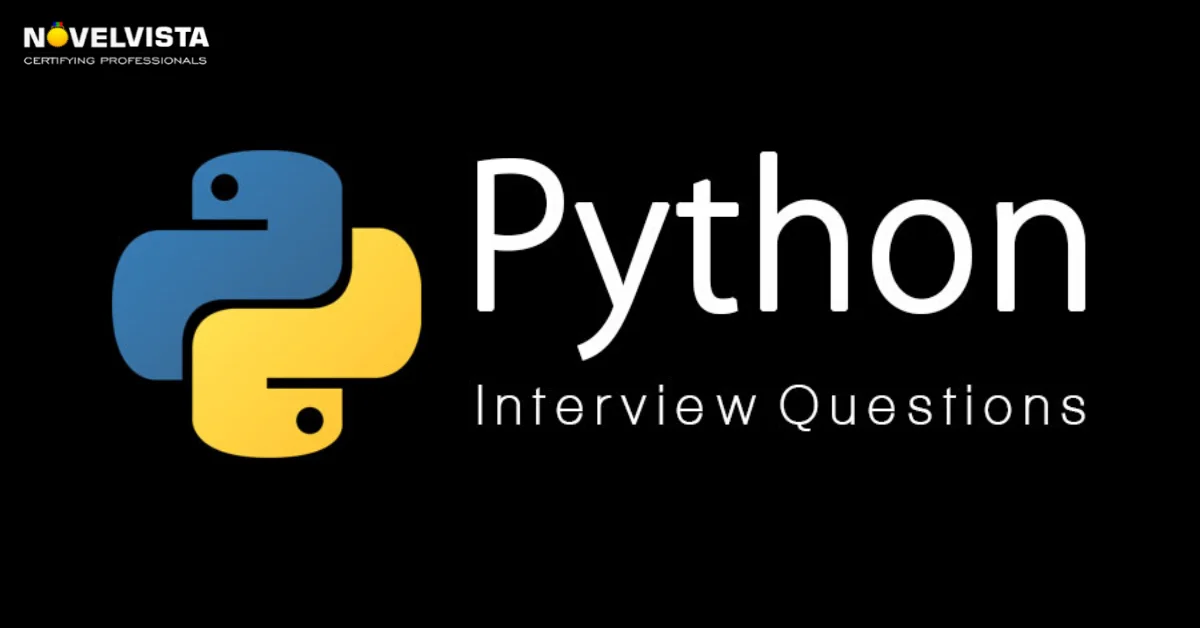- 1. What are the advantages of Python?
- 2. How is memory handled in Python?
- 3. In Python, what are decorators?
- 4. What is a dynamically typed language?
- 5. An interpreted language: what is it?
- 6. What makes a library different from a module?
- 7. Describe PEP 8 and explain its significance.
- 8. Python Namespaces: What Are They?
- 9. How many Python Namespaces are there?
- 10. Why are Namespaces in Python Used?
- 11. Which Python packages and modules are there?
- 12. What are the benefits of Python modular programming?
- 13. In Python, what is a lambda?
- 14. What do deep Copy and shallow Copy mean?
- 15. What is Pass in Python?
- 16. What are the global, private and protected attributes in Python?
- 17. What is __init__?
- 18. What is docstring in Python?
- 19. What are Python Arrays and Lists?
- 20. What is PYTHONPATH in Python?
- Conclusion:
One of the most widely used programming languages nowadays is Python. This object-oriented language is used worldwide by major enterprises to develop applications and programs. Here are some of the most common python basic interview questions that are asked during job interviews across a range of industries.
As everyone knows, Python was introduced to the team in 1991. Thus, one may wonder why a programming language that is twenty years old is still so crucial to so many different technologies. Or is learning Python really that important? Or is it simply a lot of hype?
So, let's start by discussing python technical interview questions. Python is a scripting language with straightforward syntax, powerful text processing capabilities, and a modular framework. That is why Artificial Intelligence, information security, and many other fields utilize it most frequently.
Major corporations, including CERN, NASA, Google, Wikipedia, Instagram, and Spotify, have long used Python. Therefore, you are very much screwed if you want to work with them in the future and you don't know Python! Now, concentrate on top python interview questions.
Top 20 Must-Know Python Interview Questions and Answers for Success
1. What are the advantages of Python?
Python is a general-purpose, interpreted, high-level programming language. Because it is a general-purpose language, with the appropriate tools and libraries, practically any kind of application may be created.
Furthermore, Python has support for objects, modules, threads, exception handling, and intelligent memory management, all of which are useful for modelling real-world issues and developing solutions-oriented applications.
- Advantages of Python:
Python is a general-purpose programming language that stresses readability and has an easy-to-learn syntax, making it less expensive to maintain programs. In addition, the language may be scripted, is fully open-source, and enables third-party packages that promote code reuse and modularity.
A large developer community likecoding and developeris drawn to it for Rapid Application Development and other uses due to its high-level data structures, dynamic type, and dynamic binding.
2. How is memory handled in Python?
Python makes advantage of garbage collection, an autonomous memory management system. The Python memory manager is in charge of managing memory; it allocates and deallocates memory as needed. To effectively manage memory, Python's memory manager combines memory pools with private heaps.
3. In Python, what are decorators?
Without altering the code, decorators offer a robust and adaptable technique to expand or change the behaviour of functions or methods. They let you wrap another function and run code either in front of or after the wrapped function. Decorators are frequently employed in processes like memoization, authentication, and logging.
4. What is a dynamically typed language?
If a language checks a variable's type during runtime, it is referred to as dynamically-typed. Other dynamically typed languages include Python, JavaScript, Objective-C, PHP, Ruby, Lisp, and Tcl.
Variables are bound to objects during runtime in dynamically typed languages using assignment statements. When dealing with dynamically typed languages, you may also attach the same variables to objects of different kinds while the program is running.
5. An interpreted language: what is it?
Line by line, an interpretive language puts its claims into action. Programs developed in this language don't require an intermediate compilation step because they run straight from the source code. Leading examples of interpreted languages are Ruby, R, PHP, Javascript, Python, and Javascript.
6. What makes a library different from a module?
Modules in Python are akin to stand-alone files that contain certain code elements like variables and functions. However, libraries are just enormous collections of modules that include pre-built features and tools designed for specific tasks or domains.
These libraries improve Python's capabilities by offering easily accessible solutions for a range of programming difficulties while also streamlining the development process.
7. Describe PEP 8 and explain its significance.
A Python Enhancement Proposal is the full name of the program. An official design document, or PEP, informs the Python community and outlines a new procedure or feature for Python. The stylistic rules for Python code are documented in PEP 8. You will need to adhere to these style requirements honestly and rigorously when you contribute to the Python open-source community.
8. Python Namespaces: What Are They?
Python has a feature called namespaces that ensures that object names in a program are distinct and compatible. Name as a key translated to a corresponding object as value is another term for namespaces as dictionaries.
9. How many Python Namespaces are there?
There are 3 types of Python Namespaces:
- Local Namespace
- Global Namespace
- Built-in Namespace
10. Why are Namespaces in Python Used?
When a function is called, the local namespace is momentarily formed and then removed when the function returns.
Necessary packages in the script are given their global namespace, which is generated and maintained until the script's execution is finished.
Built-in Namespace contains built-in names for different kinds of exceptions as well as built-in functions from the core Python language.
11. Which Python packages and modules are there?
Python files with a.py extension are called modules, and they can include a collection of declared and implemented functions, classes, or variables. When the user uses the import statements, they can be imported and initialized.
With the use of dot notation, packages enable the module namespaces to be organized hierarchically. Packages prevent conflicts between module names in the same manner as modules do when it comes to global variable names.
12. What are the benefits of Python modular programming?
- Simplicity:Concentrating on a tiny section of the subject at hand is made more accessible while working on a single module. This facilitates progress and reduces the unlikely chance of mistakes.
- Maintainability:Logical boundaries between various issue areas are enforced via modules. They cannot thereby influence one another.
- Reusability:A module's declared functions can be utilized by other sections of the program.
- Scoping:To assist prevent misunderstanding between identifiers from different sections of the program, modules specify a distinct namespace.
13. In Python, what is a lambda?
Python's anonymous lambda function has just one expression and can take in a large number of parameters. It is mainly employed in scenarios when a temporary unknown function is required.
14. What do deep Copy and shallow Copy mean?
A bit-wise duplicate of an object that preserves the precise values found in the original object is called a shallow copy. The reference address for any value that refers to another object will also be copied if it does.
Deep Copy transfers all values from the source to the destination object in a loop. It can also replicate the objects that the source object references.
15. What is Pass in Python?
The pass keyword shows the null operation in Python. It's generally used for the purpose of filling up the empty blocks of code which might execute at the runtime but has yet to be written. Without this statement, it might cause an error in code execution.
16. What are the global, private and protected attributes in Python?
Global variables are public variables which are defined in the worldwide scope. To make substantial use of the variable in the global scope inside the function, the Global keyword is used.
Protected attributes known as underscore are prefixed to their identifier. They can still be accessed and modified from outside the class they are defined in, but the responsible developer should refrain from doing so.
Private attributes are showcased through double underscores prefixed to their identifier. They cannot be accessed directly and will result in an AttributeError if such type of impact is made.
17. What is __init__?
__init__ is the constructor method which is automatically called to allocate memory when the new object or instance is generated. All classes have this method which is associated with them. It supports distinguishing methods and attributes of the class from local variables.
18. What is docstring in Python?
Document or docstring is the multiline string which is used to document the specific code segment. The docstring should describe what the function or method does.
19. What are Python Arrays and Lists?
Arrays in Python often only include the elements of the same data types, such as the data type of the array needs to be homogeneous. It’s like a thin wrapper around C language arrays and consumes less memory as compared to a list.
Besides this, Lists in Python can contain elements of various data types, such as data type of lists can be assorted. It also includes the disadvantage of consuming a large memory.
20. What is PYTHONPATH in Python?
PYTHONPATH is the environment variable which you can set to include the additional directories where Python will look for modules and packages. It usually is helpful in maintaining the Python libraries which you don’t wish to install in the global default location.
These are thetop 20 python interview questionsexplained above in detail. Make sure to understand each question to get to know the nature of questions and give answers with confidence.
Conclusion:
We hope that thepython question and answersmentioned above will help you to understand the criteria of questions and how you should give answers to them. Even if you have any query, make sure to reach out to us through the below comment section.
Because of its simplicity and ability to support powerful computations, Python has gained a lot of popularity among developers over the years. Therefore, there is a constant need for good Python developers.
AsGenerative AIis evolving you can also make effective use of it to get trending questions and criteria of Interview. In spite of this, it is worth mentioning that being a Python developer has its perks. So, keep learning and practising problems, and without a doubt, you will succeed at any interview.
Author Details

Vaibhav Umarvaishya
Cloud Engineer | Solution Architect
As a Cloud Engineer and AWS Solutions Architect Associate at NovelVista, I specialized in designing and deploying scalable and fault-tolerant systems on AWS. My responsibilities included selecting suitable AWS services based on specific requirements, managing AWS costs, and implementing best practices for security. I also played a pivotal role in migrating complex applications to AWS and advising on architectural decisions to optimize cloud deployments.
Confused About Certification?
Get Free Consultation Call









